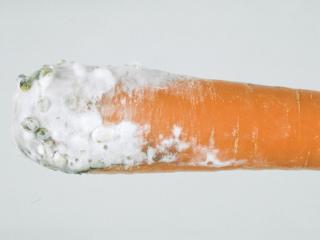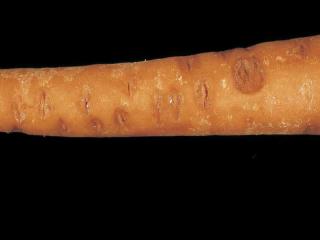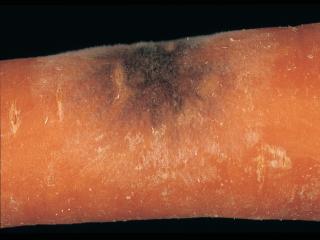Introduction
Carrots grown in Western Australia for the local market and export are usually hydro-cooled before packing and then cool-stored. Exported carrots may spend up to three weeks in cool storage and refrigerated sea containers before reaching markets.
Carrots are susceptible to a number of postharvest diseases and disorders. This page describes some of the major postharvest problems found in carrots in Western Australia and presents control measures that growers and exporters can follow for better quality carrots.
Diseases
Sclerotinia rot
Sclerotinia rot is caused by the fungus Sclerotinia sclerotiorum which can occur both in the field and in storage. The major sign of the disease is the presence of white fungal growth and small black grains (sclerotes), which look similar to mice droppings. Roots become covered with white cottony fungal growth – see Figure 1.
Control
To avoid problems with sclerotinia rot at the postharvest stage, control the disease in the field.
Other fungi such as grey mould (Botrytis cineria), crater rot (Rhizoctonia species) and black rot (Alternaria radicina) have been reported to cause postharvest losses in carrots, but these are usually prevented by using good postharvest handling and storage.
Bacterial soft rot
Bacterial soft rot is caused by the bacterium Pectobacterium carotovorum (formerly Erwinia carotovora). Affected carrots develop soft lesions (Figure 2) and eventually become a mushy and slimy mass of tissue.
Stored carrots can become affected on any part of the root and, in severe cases, an unpleasant odour is present. The tips of carrots are often affected.
The bacteria are found principally in soil and the disease becomes apparent under conditions of high soil temperature and moisture. In Western Australia, bacterial soft rot is seasonal — it is most severe under warm, wet conditions (summer and autumn) and is usually not a problem in cooler weather.
The carrot tissue, once decayed, may become infected by secondary organisms. The presence of these secondary organisms makes accurate diagnosis by pathologists difficult.
Control
- Chlorination is only recommended if carrots break down, because the disease occurs only under certain conditions. Management practices in the field and weather conditions probably predispose carrots to bacterial soft rot.
- A final rinse or spray with chlorinated water (50 to 200mg/L available chlorine and water pH 7.0 to 7.6) after washing, at entry to the grading line, will reduce bacteria.
- Use sodium or calcium hypochlorite as the source of chlorine.
- Chlorination should take place after dirt and debris are removed from the carrot root. Chlorine quickly loses effectiveness when soil, leaves or diseased roots are present in the water, so check chlorine concentration and pH often.
- Washing water should be changed as often as practical.
- There are limitations to chlorination. Chlorination acts as a preventative measure only; if there is already disease, decay or injury in the field, chlorine will help limit spread of soft rot in storage.
- Do not leave harvested carrots in bulk bins in the heat, because respirational heat in the middle of the bins will encourage disease development.
- Avoid harvesting during the heat of the day. High temperatures accelerate the rate at which disease organisms grow.
- Remove field heat from carrots by cooling as quickly as possible. Soft rot usually occurs when carrots have not been cooled adequately or cooling has been delayed.
- Minimise bruising and mechanical damage that allow entry of soft rot bacteria.
Black root rot
Black root rot is seen as blackening on the surface of the carrot. This blackening is often circular in outline, is superficial and has a sooty appearance. Either Thielaviopsis basicola (Chalara elegans) and/or Chalaropsis thielavioides cause black root rot (see Figure 3).
The fungi that cause black root rot have a wide host range and occur in soil. Carrots are likely to be contaminated with these fungi in the field before harvest.
After harvest, these fungi infect carrots through wounds or abrasions. They develop most rapidly on carrots stored at 25oC and high humidity. Black root rot often develops in pre-packed carrots kept at room temperature and when moisture is retained within the plastic bag.
Losses caused by black root rot occur during periods of hot weather when there are problems with rapid cooling of harvested carrots and maintaining the cool chain. Losses can be minimised by rapid cooling of harvested carrots and storage at 0°C.
Minimise mechanical damage during harvesting and in the packing shed and maintain packing shed hygiene.
Disorders
Phenolic browning
Phenolic browning (or surface browning) is seen as browning or discoloration of the surface of the carrot. It can develop when carrots are washed and stored in cool rooms for long periods before packing.
Abrasion caused by mechanical washing often removes the epidermal layer (outer skin), exposing the carrot tissue to oxidation of phenolic compounds, which turn brown, or black in severe cases.
Phenolic browning can be confused with ‘5 o’clock shadow’ or boron deficiency. The latter is seen as many small brown spots under the skin, causing the root to look dull.
Control
- Wash carrots as soon as possible after harvesting.
- Keep washed carrots moist.
- Don’t leave carrots in bulk bins in the cool room; pack them as soon as possible after cooling to maximise quality.
- Pack carrots into plastic-lined cartons or pre-pack plastic bags as soon as possible after harvest. Leaving carrots in bulk bins unprotected in cool store will lead to dehydration. Plastic bin liners will reduce dehydration if carrots are left for prolonged periods in bulk bins.
Bitterness
Carrots can develop off-flavours or bitterness in cool storage, caused by the production of compounds called isocoumarins. Isocoumarins develop when carrots are exposed to ethylene.
Ethylene is a gas produced naturally by many fruits and vegetables, such as apples, bananas and tomatoes, during ripening. Retailers, exporters and consumers should be aware that storing carrots with fresh products that produce ethylene can cause bitter flavours to develop in carrots. Store carrots in sealed plastic bags if domestic refrigerators contain ethylene producing fruit.
Control
Do not store carrots with fruit, vegetables or flowers that produce ethylene.
Silvering or scaling
Carrots can sometimes develop a scaly surface in storage. The carrot surface has a white, flaky appearance that looks similar to dandruff. This symptom appears when carrots become dehydrated.
Control
The use of brush polishing which removes the carrot’s outer layer (periderm) effectively removes the possibility of silvering developing.
Root breakage
Root breakage and splitting are common throughout the year. However, the proportion of breakages can increase under cooler conditions. Harvesting carrots from cold, wet ground tends to exacerbate the problem.
Control
- When possible in winter, let the soil dry out before harvest.
- Carrot varieties vary in their susceptibility to breakages. In general, Nantes types are more susceptible to breakage than Western Red and Imperator types. There are also differences among Nantes varieties in resistance to breakage. The Japanese Kuroda varieties have proved to be highly susceptible to breakage.
Other measures to improve quality
- Harvest carrots at optimum maturity. Carrots are more susceptible to decay and rots when over-mature.
- In hot weather, harvest during cool times of the day. Harvesting early in the morning will reduce both dehydration and the time taken for carrots to cool down. High temperatures accelerate the rate at which disease-causing fungi and bacteria grow.
- Harvesting into clean bins and trailers will minimise the spread of disease.
- Minimise drop height. Excessive drop heights lead to more bruising, splitting and breakage. Adjust machinery in the field and on the packing line to lower drop height. Carrots dropped at the beginning of the packing line should have padding to eliminate bruises, cracks and abrasions that serve as entry points for decay-causing fungi and bacteria.
- Transport carrots carefully — avoid excessive bouncing and shaking in trailers to reduce bruising and splitting. In hot weather, cover the carrots with a tarpaulin during transport.
- Never keep harvested carrots in the sun. Shading will reduce dehydration. Heated carrots lose quality and dehydrate more quickly.
- Pack and cool-store carrots immediately after washing.
Keeping quality
Storage life depends on storage temperature and humidity:
- At 20°C and 60 to 70% relative humidity, carrots will keep for 2 to 3 days.
- At 4°C and 80 to 90% relative humidity, carrots will keep for 1 to 2 months.
- At 0°C and 90 to 95% relative humidity, carrots will keep for up to 6 months.
- The ideal conditions for best keeping quality are pre-cooling and storage at 0°C and 95 to 100% relative humidity.
- The recommended temperature for storage is 0 to 2°C.
Acknowledgments
Recommendations are results of research and information compiled by DAFWA. Authors of this article are Allan McKay and Soonchye Tan.
Disclaimer
This material is written for Western Australian conditions.




